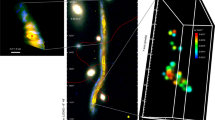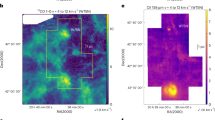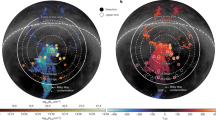Abstract
Carbon monoxide (CO) is the primary tracer for interstellar clouds where stars form, but it has never been detected in galaxies in which the oxygen abundance relative to hydrogen is less than 20 per cent of that of the Sun, even though such ‘low-metallicity’ galaxies often form stars. This raises the question of whether stars can form in dense gas without molecules, cooling to the required near-zero temperatures by atomic transitions and dust radiation rather than by molecular line emission1; and it highlights uncertainties about star formation in the early Universe, when the metallicity was generally low. Here we report the detection of CO in two regions of a local dwarf irregular galaxy, WLM, where the metallicity is 13 per cent of the solar value2,3. We use new submillimetre observations and archival far-infrared observations to estimate the cloud masses, which are both slightly greater than 100,000 solar masses. The clouds have produced stars at a rate per molecule equal to 10 per cent of that in the local Orion nebula cloud. The CO fraction of the molecular gas is also low, about 3 per cent of the Milky Way value. These results suggest that in small galaxies both star-forming cores and CO molecules become increasingly rare in molecular hydrogen clouds as the metallicity decreases.
This is a preview of subscription content, access via your institution
Access options
Subscribe to this journal
Receive 51 print issues and online access
$199.00 per year
only $3.90 per issue
Buy this article
- Purchase on Springer Link
- Instant access to full article PDF
Prices may be subject to local taxes which are calculated during checkout

Similar content being viewed by others
References
Krumholz, M. R. Star formation in atomic gas. Astrophys. J. 759, 9 (2012)
Lee, H., Skillman, E. D. & Venn, K. A. Investigating the possible anomaly between nebular and stellar oxygen abundances in the dwarf irregular galaxy WLM. Astrophys. J. 620, 223–237 (2005)
Asplund, M., Grevesse, N., Sauval, A. J. & Scott, P. The chemical composition of the sun. Annu. Rev. Astron. Astrophys. 47, 481–522 (2009)
Leaman, R. et al. The resolved structure and dynamics of an isolated dwarf galaxy: a VLT and Keck spectroscopic survey of WLM. Astrophys. J. 750, 33 (2012)
Taylor, C. L. & Klein, U. A search for CO in the Local Group dwarf irregular galaxy WLM. Astron. Astrophys. 366, 811–816 (2001)
Bigiel, F. et al. A constant molecular gas depletion time in nearby disk galaxies. Astrophys. J. 730, L13 (2011)
Taylor, C. L., Kobulnicky, H. A. & Skillman, E. D. CO emission in low-luminosity, H I-rich galaxies. Astron. J. 116, 2746–2756 (1998)
Leroy, A. K. et al. The CO-to-H2 conversion factor from infrared dust emission across the Local Group. Astrophys. J. 737, 12 (2011)
Schruba, A. et al. Low CO luminosities in dwarf galaxies. Astron. J. 143, 138 (2012)
Vassilev, V. et al. A Swedish heterodyne facility instrument for the APEX telescope. Astron. Astrophys. 490, 1157–1163 (2008)
Siringo, G. et al. The Large APEX BOlometer CAmera LABOCA. Astron. Astrophys. 497, 945–962 (2009)
Dale, D. A. et al. The Spitzer Local Volume Legacy: survey description and infrared photometry. Astrophys. J. 703, 517–556 (2009)
Planck Collaboration et al. Planck early results. XXV. Thermal dust in nearby molecular clouds. Astron. Astrophys. 536, A25 (2011)
Draine, B. T. Interstellar dust grains. Annu. Rev. Astron. Astrophys. 41, 241–289 (2003)
Galametz, M. et al. Mapping the cold dust temperatures and masses of nearby KINGFISH galaxies with Herschel. Mon. Not. R. Astron. Soc. 425, 763–787 (2012)
Coupeaud et al. Low-temperature FIR and submillimetre mass absorption coefficient of interstellar silicate dust analogues. Astron. Astrophys. 535, A124 (2011)
Galametz, M. et al. Probing the dust properties of galaxies up to submillimetre wavelengths. II. Dust-to-gas mass ratio trends with metallicity and the submm excess in dwarf galaxies. Astron. Astrophys. 532, A56 (2011)
Verdugo, C. Sub-Millimeter Studies of Cold Dust and Gas in the Magellanic Clouds. MSc thesis, Univ. Chile. (2012)
Planck Collaboration. Planck early results. XVII. Origin of the submillimetre excess dust emission in the Magellanic Clouds. Astron. Astrophys. 536, A17 (2011)
Draine, B. T. et al. Dust masses, PAH abundances, and starlight intensities in the SINGS galaxy sample. Astrophys. J. 663, 866–894 (2007)
Nikolić, S., Garay, G., Rubio, M. & Johansson, L. E. B. CO and CS in the Magellanic Clouds: a χ2-analysis of multitransitional data based on the MEP radiative transfer model. Astron. Astrophys. 471, 561–571 (2007)
Dufour, R. J. The composition of H II regions in the Magellanic Clouds. IAU Symp. 108, 353–360 (1984)
Hunter, D. A., Elmegreen, B. G. & Ludka, B. C. GALEX ultraviolet imaging of dwarf galaxies and star formation rates. Astron. J. 139, 447–475 (2010)
Leroy, A. K. et al. The star formation efficiency in nearby galaxies: measuring where gas forms stars effectively. Astron. J. 136, 2782–2845 (2008)
Lada, C. J., Forbrich, J., Lombardi, M. & Alves, J. F. Star formation rates in molecular clouds and the nature of the extragalactic scaling relations. Astrophys. J. 745, 190 (2012)
Mannucci, F. et al. LSD: Lyman-break galaxies, stellar populations and dynamics – I. Mass, metallicity and gas at z ∼ 3.1. Mon. Not. R. Astron. Soc. 398, 1915–1931 (2009)
Engelbracht, C. W. et al. Metallicity effects on dust properties in starbursting galaxies. Astrophys. J. 678, 804–827 (2008)
Zhang, H.-X., Hunter, D. A., Elmegreen, B. G., Gao, Y. & Schruba, A. Outside-in shrinking of the star-forming disks of dwarf irregular galaxies. Astron. J. 143, 47 (2012)
McMillan, P. J. Mass models of the Milky Way. Mon. Not. R. Astron. Soc. 414, 2446–2457 (2011)
Chomiuk, L. & Povich, M. S. Toward a unification of star formation rate determinations in the Milky Way and other galaxies. Astron. J. 142, 197 (2011)
Acknowledgements
This work was funded in part by the US National Science Foundation through grants AST-0707563 and AST-0707426 to D.A.H. and B.G.E. M.R. and C.V. wish to acknowledge support from CONICYT (FONDECYT grant no. 1080335). M.R. was also supported by the Chilean Center for Astrophysics FONDAP grant no. 15010003. A.S. was supported by the Deutsche Forschungsgemeinschaft Priority Program 1177. We are grateful to M. Albrecht for help with the LABOCA data reduction and to L. Hill for making Fig. 1a. The National Radio Astronomy Observatory is a facility of the US National Science Foundation operated under cooperative agreement by Associated Universities, Inc.
Author information
Authors and Affiliations
Contributions
B.G.E. coordinated the observational team, did the calculations for Table 2 and wrote the manuscript; M.R. was principal investigator for Chilean observing time on the APEX telescope and, with C.V., observed the galaxy in CO and at 870 μm, reduced the relevant data in Table 1 and did relevant calculations for Table 2; D.A.H. determined the observational strategy, selected WLM for study, chose the observing coordinates, extracted the H i spectra from the LITTLE THINGS data and prepared Fig. 1. E.B. was principal investigator on the APEX proposal using European time through ESO and coordinated the work on data uncertainties and background noise. A.S. made the WLM H i data cube from Jansky Very Large Array observations. All authors discussed the results and commented on the manuscript.
Corresponding author
Ethics declarations
Competing interests
The authors declare no competing financial interests.
Supplementary information
Supplementary Tables
This file contains Supplementary Table 3 (see main text for Tables 1 and 2). (PDF 44 kb)
PowerPoint slides
Rights and permissions
About this article
Cite this article
Elmegreen, B., Rubio, M., Hunter, D. et al. Carbon monoxide in clouds at low metallicity in the dwarf irregular galaxy WLM. Nature 495, 487–489 (2013). https://doi.org/10.1038/nature11933
Received:
Accepted:
Published:
Issue Date:
DOI: https://doi.org/10.1038/nature11933
This article is cited by
-
Massive stars in extremely metal-poor galaxies: a window into the past
Experimental Astronomy (2021)
-
Carbon monoxide in an extremely metal-poor galaxy
Nature Communications (2016)
-
Extragalactic HI surveys
The Astronomy and Astrophysics Review (2016)
-
Glimpse into a primitive stellar nursery
Nature (2015)
-
Dense cloud cores revealed by CO in the low metallicity dwarf galaxy WLM
Nature (2015)
Comments
By submitting a comment you agree to abide by our Terms and Community Guidelines. If you find something abusive or that does not comply with our terms or guidelines please flag it as inappropriate.



